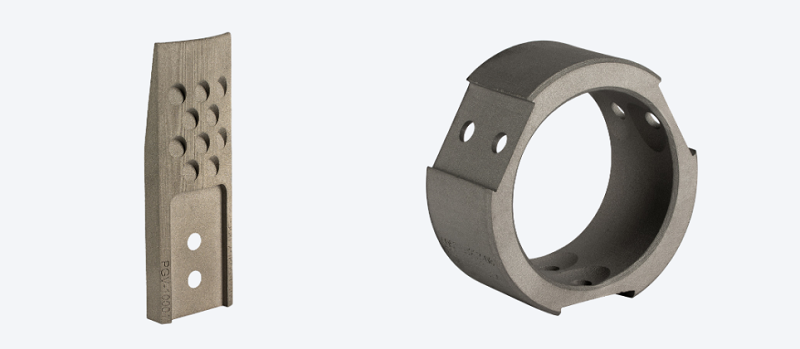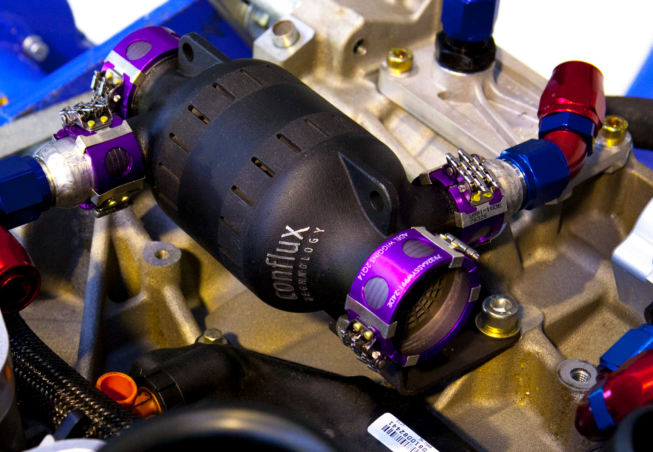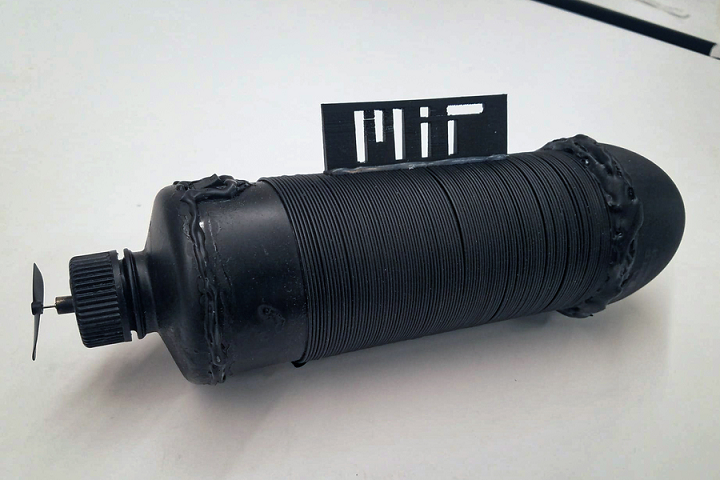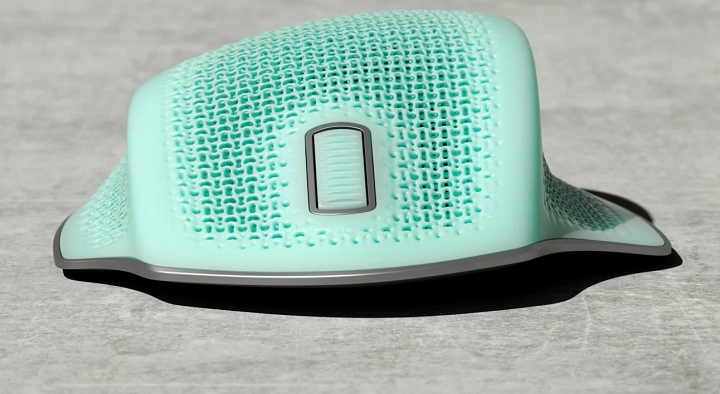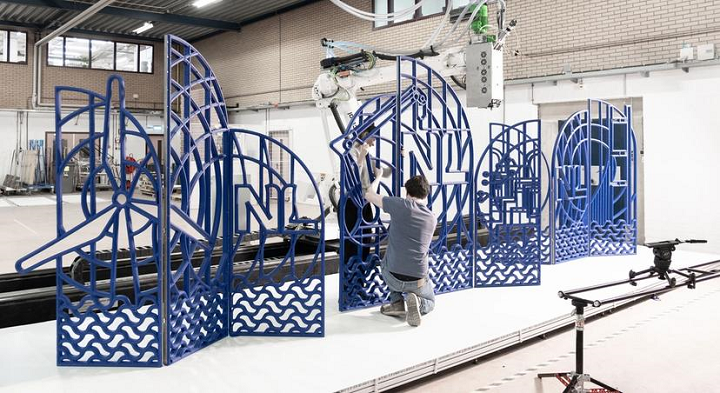Starting with material news in today’s 3D Printing News Briefs, Velo3D has qualified a new superalloy for its Sapphire 3D printers. Equipment manufacturer PGV is saving time and money with Desktop Metal’s technology, Conflux and Dallara Automobili are working together on 3D printed heat exchangers, and MIT engineers 3D printed what’s being called the world’s longest flexible fiber battery. The 3D printed mesh design of a new wireless house was inspired by adidas running shoes, and finally, the Netherlands Pavilion at CES 2022 opened with a 3D printed art display.
Velo3D Qualified Nickel-Based Superalloy for Sapphire Printers

3D printed combustor liner made using Amperprint 0233 Haynes 282 powder from Höganäs. The part features 23,000 unique holes for optimized air-to-fuel ratios and internal channels for regenerative cooling, and is shown as printed, with no supports.
Metal 3D printing leader Velo3D (NYSE: VLD) announced that it has qualified a nickel-based superalloy powder for use with its Sapphire 3D printer family. Produced by powder specialist Höganäs AB and under license from Haynes International, Amperprint® 0233 Haynes® 282® was designed for the thermal stability, weldability, high creep strength, crack resistance, and fabricability not often offered in other alloys, which is why it’s good for structural, high-temperature industries like gas turbines, energy generation, and space launch vehicles to use for applications like nozzles, combustion liners, heat exchangers, shrouded impellers, and more. Velo3D is said to be one of the first AM companies to offer this superalloy powder to its customers, and the first Sapphire system to use the company’s new Amperprint® 0233 Haynes® 282® will be Oklahoma-based contract manufacturer Duncan Machine Products (DMP), which has a fleet of seven Velo3D Sapphire 3D printers.
“It’s inspiring to see what engineers have been able to build using metal powders from Höganäs and Velo3D’s support-free additive manufacturing process. The first parts printed using our Amperprint® 0233 Haynes® 282® powder are impressive, and I believe customers are only scratching the surface of what is possible with this superalloy,” said erome Stanley, Höganäs Director of Global Sales, Customization Technologies. The powder, combined with Velo3D’s end-to-end solution metal AM solution, is an extremely effective combination for consolidating parts into monolithic structures to eliminate coefficient of thermal expansion in large, high-performance systems.”
PGV Reduces Lead Times & Physical Inventory with Desktop Metal
Another leader in metal AM, Desktop Metal (NYSE: DM), recently produced a case study with customer PGV, which manufactures equipment for the oil and gas, aerospace and robotics, and automation industries. Based in Texas, PGV has long used CNC machining to help manufacturing customers take on common challenges like inventory management, high tooling costs and lead time, and lack of agility, but as metal 3D printing has continued to grow in recent years, the company realized it could address all of these challenges with the Desktop Metal Shop System. PGV installed the metal binder jetting 3D printer less than a year ago, and reports that it has helped decrease physical inventory by 50%, reduce lead times by 50-80%, free up internal production capacity, and simplify inventory management. The Shop System has been used by PGV to print a variety of parts, including tool sips, tubing anchors, pistons, and more.
“As part of their desire to incorporate next-generation manufacturing into their shop, PGV explored a wide range of metal 3D printing options, and chose the Shop System based on extensive benchmarking and testing,” the case study explains.
“Among the key factors for the company were the excellent material properties displayed by Shop System parts. In key characteristics like strength, ductility and hardness, parts produced on the Shop System meet or exceed those of traditionally-manufactured parts, ensuring they can stand up to the tough conditions they’ll face in downhole operations.”
Dallara Automobili & Conflux Developing 3D Printed Heat Exchangers
Italian racecar manufacturer Dallara Automobili has partnered up with Australian AM company Conflux Technology to develop 3D printed heat exchangers. Dallara has a pretty positive reputation, as the company is a contract builder for every motorsport category in the world. Conflux began its work with 3D printing in the motorsport industry, so this project has some special significance to the company, as well as acting as a proof of performance for its capabilities and commercially viable products. The 3D printed heat exchangers—a growing AM application—are due for delivery next month.
“Conflux heat exchangers derive their performance from highly complex geometries that make use of the inherent freedoms afforded by Additive Manufacturing,” explained Michael Fuller, the CEO and Founder of Conflux Technology. “Dallara set us an initial challenge to produce small heat exchangers that meet stringent performance, quality and cost targets. To achieve this, our engineers are working alongside Dallara personnel with the ultimate aim to improve fundamental efficiencies in the automotive and motorsport sector.”
“World’s Longest” Flexible 3D Printed Fiber Battery
A team of MIT engineers developed a rechargeable lithium-ion battery in the form of a flexible, ultra-long fiber that can woven into fabrics, and even 3D printed, for a new type of wearable electronic device or structured casing. Fibers have been used in wearable products before, but they required an external power source; using this weavable fiber battery, these devices could one day be self-contained, which would be helpful for sensing, communications, and computational device applications. The team used novel battery gels to manufacture the battery with a standard fiber-drawing system that heats the components to just below the melting point, and the material is then extruded to compress the parts so that they’re much smaller, but still in the original arrangement. Lithium and other materials are embedded inside the fiber, and the whole thing is waterproof and stable thanks to a protective outside coating. The engineers demonstrated their research by manufacturing a 140-meter-long fiber battery that’s only a few hundred microns thick and has an energy storage capacity of 123 milliamps an hour, which is enough to charge a smartphone or watch. According to MIT postdoc Tural Khudiyev, this is the first system that can help achieve 3D printing complex objects that incorporate a battery device.
“This is the first 3D printing of a fiber battery device. After printing, you do not need to add anything else, because everything is already inside the fiber, all the metals, all the active materials. It’s just a one-step printing. That’s a first,” said Khudiyev, one of the lead authors of the research.
adidas Shoes Inspire Wireless Mouse with 3D Printed Mesh
Designer Matt Barnum designed what he refers to as an Ergonomic Mouse, but it’s also been dubbed the Squishy Mouse, largely due to the soft 3D printed mesh that looks a lot like the lattice structures seen in adidas Futurecraft running shoes. The design of the wireless mouse, which rests on a metal base for easy gliding on smooth surfaces, was part of a learning process for Barnum, who wanted to improve his generative design tool skills, and the term ‘ergonomic’ was given because of its breathable design that is flexible enough to conform to the shape of your hand and offer a similar experience to that of a stress ball.
“The Squishy Mouse comes in the same mint green as the 3D-printed Adidas soles, highlighting that source of inspiration almost instantly,” explains a Yanko design analysis. “While it’s unclear whether the mouse intends to use the same printing techniques as seen in Adidas soles, it makes sense from a material perspective. Digital Light Synthesis (or DLS) 3D printing allows light to cure resin in complex shapes, creating designs out of flexible elastomers that are much smoother to look at too. In this case, Barnum’s use of the lattice around areas of contact allows those specific areas to remain flexible, while the edges and contours of the mouse are relatively solid, allowing the Squishy Mouse to basically be squeezed or squished without losing its shape. Notably, even the left and right-click buttons have the lattice texture, offering essentially an absolutely new way of input that’s more squishy instead of clicky (whether that’s a win or fail from a haptic point of view is yet to be determined). That, along with the overall texture of the mouse would easily add a new UX dimension during use, and chances are that you’ll either absolutely hate it, or absolutely love it.”
XL 3D Printed Art Display at CES 2022’s Netherlands Pavilion
Finally, the Netherlands (NL Tech) Pavilions at the recent CES 2022 in Las Vegas opened with a unique art display in the form of three extra-large, circular 3D printed room dividers by Aectual. The 3D printed dividers, which were used in the seating area of the temporary convention center in Amsterdam for the EU presidency of the Netherlands in 2016, were made from what’s been called “100% circular, sustainable, recycled and renewable materials.” Aectual takes the plant-based bioplastic of its used products and recycles and reprints it into new items up to seven times, which can result in a material reduction of 35-95%. These 3D printed room dividers acted as a storyboard to reference the CES 2022 Dutch theme of “Tech for a Responsible Future.” The NL Tech Pavilions were dedicated to foster collaboration and partnerships, as well as introducing technology solutions to solve global challenges in multiple categories, such as smart mobility, data security, artificial intelligence, robotics and quantum computing, and more.
“The NL Tech Pavilion at CES 2022 includes two pavilions for the first time, which demonstrates and maps to the immense growth of the Netherlands tech ecosystem over the past several years. In order to solve the urgent challenges we face today, we need to design solutions for the world we will live in tomorrow. Our start-ups and scale-ups have answered the call to accelerate the change together,” said HRH Prince Constantijn van Oranje, Special Envoy to Techleap.nl and the Netherlands.
Following the theme of reusability, the 3D printed room dividers are now being used at the Consulate General of the Netherlands in San Francisco.
Subscribe to Our Email Newsletter
Stay up-to-date on all the latest news from the 3D printing industry and receive information and offers from third party vendors.
You May Also Like
Further Understanding of 3D Printing Design at ADDITIV Design World
ADDITIV is back once again! This time, the virtual platform for additive manufacturing will be holding the first-ever edition of ADDITIV Design World on May 23rd from 9:00 AM –...
3D Printer Maker EVO-tech Reborn as NEVO3D — Once More With Feeling
EVO-tech was a 3D printing service and original equipment manufacturer established in 2013 and based in Schörfling am Attersee, Austria. The company produced high-quality material extrusion systems featuring linear bearings,...
3D Systems Brings 3D Printed PEEK Cranial Implant to the U.S. with FDA Clearance
For more than 10 years, 3D Systems (NYSE:DDD) has worked hand-in-hand with surgeons to plan over 150,000 patient-specific cases, and develop more than two million instruments and implants from its...
CDFAM Returns to Berlin for Second Annual Symposium
The second CDFAM Computational Design Symposium is scheduled for May 7-8, 2024, in Berlin, and will convene leading experts in computational design across all scales. Building upon the first event...


